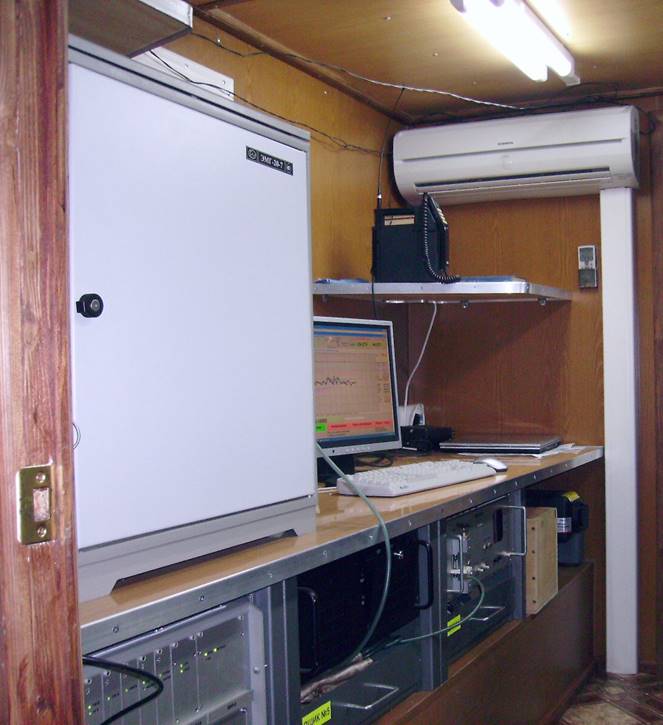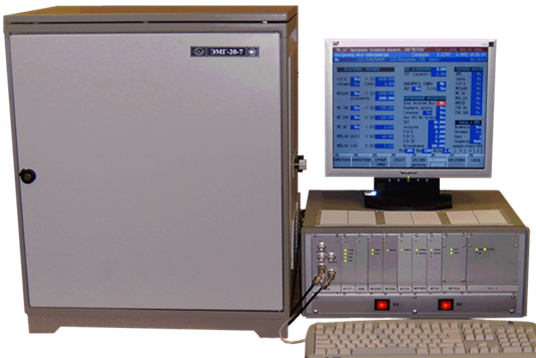-
Products
- Gas analysis systems
- GAOS SENSON gas analyzers
- GAOS MS process mass spectrometry
- MaOS HiSpec ion mobility spectrometer
- MaOS AxiSpec ion mobility spectrometer
- Applications
- News
- Events
- About us
|
The MS process mass-spectrometer provides real-time, fast, accurate, comprehensive gas analysis.
Operational characteristics:
|
|

|
|
Mass-spectrometer GAOS MS-20-7 |
||

|
||
|
|
Depending on the analytical applications, the process mass spectrometers MS are equipped with various modifications of the Sample Conditioning System.
SAMPLE CONDITIONING SYSTEM SPECIFICATIONS
Temperature up to 1200 °С; Dust content up to 30 g/m3; Pressure (10-3÷3) bar; Presence of a condensate, aggressive gases;
|
|
METALLURGY
Basic Oxygen Steel process (converter);
Blast Furnace Optimization;
Steel Vacuum Processing (VOD, RH);
Air separation (analysis of blowing oxygen purity);
Emissions Monitoring and Pilot Plant Gas Analysis for non- ferrous metallurgy.
GEOLOGY
Mud Gas Logging;
Isotope Analysis;
Gas Measuring;
Fluid Inclusions Gas Analysis (geochemistry investigations).
OIL AND GAS INDUSTRY
LNG production;
Natural gas processing;
Hydro-cracking process;
High-temperature cracking furnace optimization;
Process of the catalyst regeneration;
The chemical analysis of technological gases: recycle hydrogen, fuel, inert.
ATOMIC ENERGY
Chemical and isotope analysis of H2-He-T2 fuel gas mixtures (International project "ITER" - experimental thermonuclear reactor);
Chemical and isotope analysis of gas phase of the fuel elements cover;
Monitoring of hydrogen and other gases migration during the atomic reactor stress testing.
HIGH-PURITY GAS PRODUCTION
ALTERNATIVE ENERGY
Plasma gasification of the solid waste with the reception of synthesis-gas for power and chemical industry;
Optimize hydrogen reformer and catalyst efficiency for fuel cell development and testing.
INVESTIGATIVE ANALYSIS
Monitoring of the gas phase for thermal, thermogravimetric analysis;
The elemental analysis (C, N, O), quantity determination of the dissolved gases in metals;
Pilot plant gas analysis of the metallurgical processes.
Mud gas logging –is an investigation method for studying the composition of hydrocarbon and other gases in the chisel solution, directly during the drilling process and a sampling of the discrete probe.
Mud gas logging is a direct method for identifying and evaluating the characteristics of productive layers of oil and gas and other geological objects in the well section in the process of production and exploration drilling for oil and gas.
Modern technologies for the construction of oil and gas wells, including high-speed drilling (> 50 m / h), drilling directional and horizontal wells, carrying out comprehensive geological and technological research directly in the drilling process without performing downhill work, determine the need for more informative analytical methods for mud gas logging:
quantity of measured components;
simultaneous determination of organic and inorganic components;
wide dynamic range;
high rate of measurements;
isotope analysis.



|
The device was developed by the request of OJSC “Surgutneftegaz”, for operation as part of geotechnical research stations. The mass spectrometer provides the logging of mud gas during exploration and production drilling for oil and gas.
GAOS MS-20-7 allows you to reliably determine the depth of drilling, to identify oil deposits and to predict the effectiveness of reservoirs due to:
|
The software of the GAOS MS-20-7 mass spectrometer supports the international protocols WITS/WITSML and allows carrying out the function of the remote access and control with a display of the current information on the mud gas logging, to working parameters and a device condition. By means of modern wire and satellite Internet technologies, it is possible to provide diagnostics, adjustment, and mass spectrometer calibration in the real-time mode, to supervise process and data quality of mud gas logging.

The diagram of the mud gas logging adhered to a depth of the drilling.
GAOS MS-20-7 mass spectrometer allows to register contrast the oil and gas layers capacity from 0,5 meters, authentically and precisely to define the gas-oil contact at horizontal drilling at a capacity of a layer to 5 meters that is important taking into account of the full development of the basic deposits in Western Siberia and the European part of Russia.
Information obtained using a mass spectrometer: separation of the depth and characteristics of all oil layers, including low-power ones, allows you to make a choice for applying punching operations, hydraulic fracturing, drilling lateral boreholes to increase and restore oil return during operation and after capital well repair.
An important function of the GAOS MS gas analysis complex as a part of the station of the geological and technological investigations is the safety of the drilling: high performance of the mass spectrometer allows to predict operatively possible emissions of gas (allocation and the forecast of zones with abnormal high sheeted pressure), and also to register toxic gases: hydrogen sulfide, carbon oxide.
The mass spectrometer GAOS MS-20-7 is a compact and mobile device with the possibility of transportation by road and helicopter transport in off-road conditions and low temperatures. He passed the test of reliability in harsh conditions on existing drilling sites (vibration and shock, temperature differences).
Currently, more than 50 mass spectrometers are maintained, which are used for logging drilling gas in prospecting and technological drilling of wells in fields in Western Siberia.

Placement of the GAOS MS-20-7 mass spectrometer at the geological and technological station in “Razrez-2”
|
Component |
Concentration, % vol. |
Deviation, % vol. |
SD, % vol. |
|
|
Standard |
Measured |
|||
|
CH4 |
10,31±0,01 |
10,297 |
0,013 |
0,042 |
|
C2H6 |
1,99±0,09 |
2,075 |
0,085 |
0,004 |
|
C3H8 |
0,99±0,03 |
1,024 |
0,034 |
0,0012 |
|
C4H10 |
0,533±0,050 |
0,583 |
0,050 |
0,0002 |
|
i-C4H10 |
0,054±0,006 |
0,048 |
0,006 |
0,0005 |
|
C5H12 |
0,0098±0,0006 |
0,00989 |
0,00009 |
0,00004 |
|
C6H14 |
0,000117±0,00007 |
0,00118 |
0,00001 |
0,00001 |
The metrological characteristics of the mass spectrometer GAOS MS-20-7 were checked on the basis of the State primary standard for mass concentration of gas components GET 154-2001, D.I. Mendeleyev Metrological Institute, St.-Petersburg.
The use of the GAOS MS-20-7 mass spectrometer is especially important in exploratory drilling: the instrument allows for isotopic analysis in the field, and helium is recorded as a natural marker of oil and gas deposits. The gas sample injection system allows both continuous analysis while drilling and discrete analysis of core samples by thermal vacuum degassing and thermal analysis.
Application of the GAOS MS-20-7 mass spectrometer in geology:
|
Range of registered masses, Da |
1÷200 |
|
Resolution at 10 % level, M/ΔM |
200 |
|
Measured components: |
СH4, С2H6, C3H8, i-C4H10, C4H10, C5H12, C6H14, H2, He, N2, Ar, O2, CO2, H2S, SO2
|
|
Dynamic range, % vol. |
0,0001÷100 |
|
Rate, scan/s |
20 000 |
|
Duration of the analysis cycle, s, no more |
1 |
|
Chanel of the registration system: |
|
|
|
16 |
|
|
16 |
|
Automated self-calibration
|
|
|
Automated correction of the baseline
|
|
